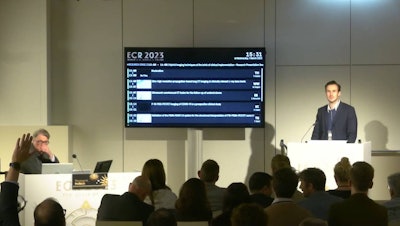
Researchers in Germany have validated a system called PSMA-RADS 1.0 for clinicians to interpret PET/CT scans in patients with prostate cancer, according to a presentation on 1 March at ECR 2023 in Vienna.
In a session covering hybrid imaging techniques on the brink of clinical implementation, Dr. Thomas Geyer of Ludwig Maximilian University Munich presented a reader study that assessed the feasibility of PSMA-RADS in clinical routine. The study found that PSMA-RADS 1.0 is highly accurate for stratifying prostate cancer lesions in PSMA-PET/CT imaging.
"We think that especially for inexperienced readers, in order to gain confidence and experience in the reading PSMA-PET/CT scans, this approach can help to simplify and standardize the diagnosis of prostate cancer patients," Geyer said.
As with most imaging tests, PSMA-targeted PET imaging of prostate cancer patients has potential interpretive pitfalls and equivocal findings. PSMA-RADS 1.0 was introduced in 2018 by researchers at Johns Hopkins University School of Medicine in Baltimore, MD. The system is designed to provide guidance and structure in the interpretation and reading of PSMA-PET/CT scans using F-18 or gallium-68-labeled radiotracers.
The system is organized around a 5-point scale, with higher numbers indicating a greater probability of prostate cancer, Geyer explained. At the lower end of the scale, PSMA-RADS-1 and PSMA-RADS-2 lesions are either certainly or almost certainly benign, while PSMA-RADS-4 indicates a high likelihood that prostate cancer is present and PSMA-RADS-5 lesions almost certainly represent cancer in patients, he said. Primarily, lesions are classified based on how much radiotracer uptake is observed on the PET/CT scans.
 Dr. Thomas Geyer of Ludwig Maximilian University Munich presented a study on PSMA-RADS 1.0 during a session on 1 March in Vienna.
Dr. Thomas Geyer of Ludwig Maximilian University Munich presented a study on PSMA-RADS 1.0 during a session on 1 March in Vienna.In this study, Geyer and colleagues used 103 scans from patients with either histologically confirmed or suspected prostate cancer. During two sessions four weeks apart, four readers -- two with more than seven years of experience and two with less than two years of experience -- classified imaging findings using PSMA-RADS scores.
In an analysis, agreement rates between the readers were very high, with experienced readers achieving an interreader agreement rate in overall scan scores of 0.897 for the first read and 0.826 for the second read. The inexperienced readers achieved an interreader agreement rate of 0.746 on the first read and 0.767 on the second read.
"We can say that PSMA-RADS 1.0 is a highly reproducible and accurate system for stratifying lesions in PSMA-PET/CT imaging," Geyer concluded.
In a discussion after the presentation, Geyer added that PSMA-RADS 1.0 may be effective not just for diagnosing prostate cancer patients, but for staging patients for surgery as well as monitoring their response to treatment.



















